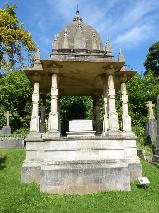Ram Mohan Roy |
| POLITICIAN (INDIA) |
|
BORN 22 May 1772, Radhanagar, Bengal - DIED 27 Sep 1833, Bristol: Stapleton CAUSE OF DEATH meningitis GRAVE LOCATION Bristol: Arnos Vale Cemetery, Bath Road |
|
Because his parents had different ideas, Raja Ram Mohan Roy was educated for the occupation of scholar as well as for public administration. In 1820, he became the founder of the Brahmo Sabha movement that resulted in the social and religious Brahmo Sabha movement. He was opposed to Sati, the practice of burying widows when their husbands died in Bengal and actively and successfully challenged it. He aimed to integrate elements of western culture with Indian traditions. In 1830 he went to the United Kingdom as an ambassador to the Munghal Empire to warn against overturning the regulation that banned the Sati practice. He exchanged ideas with English parliamentarians on Indian economics and law and he also visited France. In 1833 he died of meningitis near Bristol and he was buried at Stapleton in Bristol. In 1843 he was reinterred in the new Arnos Vales cemetery. His mausoleum was designed by William Prinsep. |
| Images |
Sources • Raja Ram Mohan Roy - Wikipedia (EN) |




